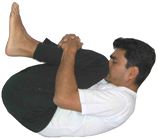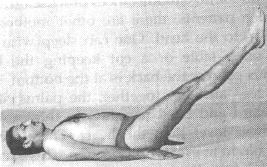 In Sanskrit "Pavan" means air, "Mukta" means release or free. As its name suggests, this asana gives relief from excess wind in the belly. This asana can be performed by raising one leg or both the legs.
In Sanskrit "Pavan" means air, "Mukta" means release or free. As its name suggests, this asana gives relief from excess wind in the belly. This asana can be performed by raising one leg or both the legs.Other names : Wind freeing posture, Wind releaving pose, Knee squeeze posture.
Technique :
- Lie flat on the back. Keep the heels of both the legs together.
- Inhale deeply and bend the right knee towards the stomach and hold it with both the hands.
- Rise the head above the ground and bring the chin closer to the knee so that it touches the knee-cap.
- Exhale and press the muscles of the right abdomen with the right thigh.
- Keep the stomach pressed till the breath is suspended.
- This asana is called "Dakshina Pavanamuktasana". If this asana is performed with the left leg, it is called "Vama Pavanamuktasana". Practice this exercise with both the legs together. This is called "Purna Pavanamuktasana".
- While holding the legs with both the hands, exhale and control the breathing. Remain in this posture for 3-4 seconds.
- Then slowly begin inhaling while stretching the legs out.
Benefits of Pavanamuktasana :
- This asana reduces obesity of the body and the fat around the abdomen.
- This asana is the best natural way to get rid of foul gases.
- It prevents heart-trouble and improves the working of the lungs.
- This asana releases the muscles of the lower back and relaxes the body.
- It is also useful in the treatment of impotence, sterility and menstrual problems.
- It also ensures a regulating of wind present in the body.
- This asana cures diseases as gas, constipation, the disorders of the uterus, intestinal worms, appendicitis, rheumatism, piles, blood impurities, windiness in the stomach etc.
Contra indication :
People who suffered from back problems, spinal injuries, sciatica should avoid this asana. Pregnant women should avoid it.







